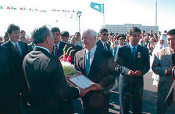International
Kazakhstan more energetic than most of FSUMore than ever, Western oilmen are rolling their eyes and cursing under their breath about the status of projects and legislation in many republics of the Former Soviet Union (FSU). Russia is a bureaucratic quagmire, wracked by excessive taxes and inhibited by a feeble President Boris Yeltsin. Azerbaijan’s exploratory prospects have not fulfilled expectations, prompting several consortiums to pull out or reduce operations. In Turkmenistan, oil and gas policy has been very inconsistent, and the isolationist regime can be difficult to deal with. Among larger FSU republics, Kazakhstan is a hopeful exception. Despite some grumbling by E&P executives that governmental policy has serious flaws, activity remains relatively strong, and money continues to flow into the country. For example, Chevron is vigorously funneling investment into further development of giant Tengiz field. At the Kazakhstan International Oil and Gas Exhibition last month, Chevron’s Eurasia Business Unit leader, Nick Zana, stated that his firm will boost crude output to 260,000 bpd by mid-2000, up from the current 220,000 bpd. By 2004, Zana expects production to rise to 370,000 bopd. Expansion of production capacity and introduction of sour gas injection will cost $3 billion. Meanwhile, Chevron also wants to increase its shareholding in the Tengizchevroil joint venture, back to the original 50% stake, or greater. The company holds 45%, along with Mobil (25%), state firm Kazakhoil (25%) and Arco/LUKoil (5%). There is a good chance that this will occur, and the likely party to sell is Kazakhoil. The government is struggling to contribute its share of the JV’s development costs, so officials are considering the sale of 40% of Kazakhoil’s holding.
Another example of confidence is the recent spudding of the country’s first offshore wildcat in the Caspian Sea. Offshore Kazakhstan International Operating Co. (OKIOC) spudded the Kashagan East well over a substantial structure, delineated by seismic surveys to be 77 km (48 mi) long. Parker Drilling Co.’s Sunkar barge rig is handling the project, about 180 km (112 mi) offshore in only 3 to 4 m (10 to 13 ft) of water. According to OKIOC, drilling should penetrate the actual reservoir late this year, but the well will not be tested until later next year, after the winter ice has melted. Back onshore, Agip and partners remain committed to spending $2 billion through 2002, to develop Karachaganak gas / condensate field. Initial output will be roughly 80,000 bpd, increasing to about 190,000 bpd by 2003. So given these various examples, Kazakhstan must be doing something right. Nevertheless, Western oilmen complain that the government suffers from too many layers of bureaucracy and needs to do more to reduce them. The problem is particularly acute at the local level, where administrative responsibilities overlap, increasing the chances that graft and corruption will occur. Other complaints include a lack of training for mid-grade and lower-level governmental employees, lack of a natural gas development policy and a need for further economic reforms. Ironically, Kazakh Prime Minister Nurlan Balgimbayev resigned last month after nearly two years in office, preparatory to taking over the Kazakhoil presidency. It will be interesting to see how he addresses the complaints in his new role. Apache closes another large deal. Adhering to the pattern it has established throughout the 1990s, Apache Corp. is growing again by picking up a large chunk of major oil company cast-offs. This time, the firm is buying producing properties and other assets in Alberta, British Columbia and Saskatchewan from Shell Canada for $524 million. The properties contain 87.5 million boe; more than 294,000 acres of undeveloped leaseholdings; a 100% interest in a gas processing plant with a 160-MMcfd potential; and seismic information totaling 52,700 mi of 2-D data and 884 sq mi of 3-D data. Apache has declared this acquisition a "strategic step," pledging to develop existing fields "to their potential." There are plans to generate 20 or more exploration prospects annually among these assets. At least 10 exploratory wells also will be drilled in the next six months. Including this deal, Apache has acquired about $1.4 billion in assets during 1999. Brazil firms up second offering. Brazil’s National Petroleum Agency (ANP) has released details of its next licensing round, set for second-quarter 2000. ANP will offer 13 offshore and 10 onshore blocks. Offshore tracts include five blocks in the Santos basin and four in the Campos basin. ANP Director David Zylbersztajn said his agency "learned a lot" from problems experienced during the first round and has applied those lessons to the next offering. For example, each new block is half the size of tracts in round one. A greater variety of terrain and potential formations also are included. Deepwater well
spudded offshore Israel. An $8.5-million wildcat began drilling last month in a
2,297-ft water depth, within the Israeli portion of the Mediterranean Sea. Isramco, Inc.,
and six partners planned to drill the Or 1 to about 6,560 ft, using the Atwood Eagle
semisubmersible rig. The well was targeting a natural gas prospect identified by seismic.
Drilling was expected to take 30 days. Copyright © 1999 World
Oil |
- Applying ultra-deep LWD resistivity technology successfully in a SAGD operation (May 2019)
- Adoption of wireless intelligent completions advances (May 2019)
- Majors double down as takeaway crunch eases (April 2019)
- What’s new in well logging and formation evaluation (April 2019)
- Qualification of a 20,000-psi subsea BOP: A collaborative approach (February 2019)
- ConocoPhillips’ Greg Leveille sees rapid trajectory of technical advancement continuing (February 2019)




